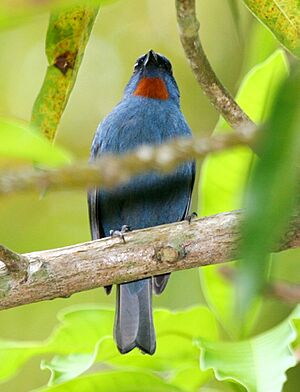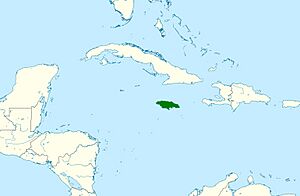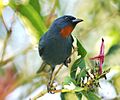Orangequit facts for kids
Quick facts for kids Orangequit |
|
|---|---|
 |
|
| Male | |
| Conservation status | |
| Scientific classification | |
| Genus: |
Euneornis
|
| Species: |
campestris
|
 |
|
| range | |
| Synonyms | |
|
Motacilla campestris (protonym) |
|
The orangequit (Euneornis campestris) is a small, colorful passerine bird. It belongs to the tanager family. This bird is special because it's the only type of bird in its genus called Euneornis.
You can only find the orangequit in Jamaica. It lives in warm, wet subtropical or tropical forests. It can also be found in areas where forests used to be but are now changed.
Reproduction and Life Cycle
Orangequits usually lay their eggs between April and June. They build their nests from grass and plant fibers. These nests are often placed high up in trees, sometimes almost six meters (about 20 feet) off the ground.
A female orangequit typically lays 2 to 4 eggs at a time. She then sits on the eggs to keep them warm until they hatch. Male and female orangequits look different from each other. Their appearance also changes as they get older.
About the Orangequit's Name
The orangequit was first officially described in 1758. A Swedish scientist named Carl Linnaeus gave it the scientific name Motacilla campestris. He wrote about it in his famous book, Systema Naturae.
Linnaeus learned about this bird from George Edwards. Edwards was an English naturalist who had described and drawn the "American Hedge-Sparrow" in 1750. He had seen a specimen collected in Jamaica. Later, in 1856, an Austrian zoologist named Leopold Fitzinger moved the bird to its own genus, Euneornis.
The common name "orangequit" comes from two things. The first part, "orange," describes its bright orange throat. The second part, "quit," is an old English word. It refers to small passerines found in tropical America. You might hear it in names like grassquit or bananaquit.
Gallery






